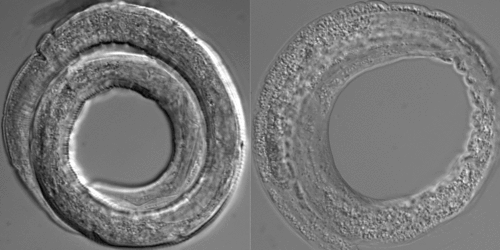
Hydrated vs. desiccated worm.
A research team at the Max Planck Institute of Molecular Cell Biology and Genetics (MPI-CBG) found the generic toolkit that enables plants and animals to survive extreme situations without water. In 2011, the scientists could show that the dauer larva of the soil worm Caenorhabditis elegans can lose most of their body water but stay alive in a suspended animation state known as anhydrobiosis. Now, they identified a number of genes, proteins and biochemical pathways that are triggered upon sensing a mildly dry environment. In this way, they help to prepare the organism for the harsher conditions of an imminent drought.
The nematodes can sense such a change in the humidity of the environment via head neurons, which then activate the preparation response to the stress situation. As a consequence, the worms get rid of a number of chemicals that can be oxidized, and start producing proteins that are associated with a heat shock.
The researchers used a systems approach with a wide range of methods such as microarray analysis, proteomics, and bioinformatics to identify the molecular mechanisms that are activated in this state. Remarkably, this response involves only a small number of functional pathways: “This means it represents the generic toolkit for anhydrobiosis in plants and animals”, says Teymuras Kurzchalia, research group leader at the MPI-CBG and lead investigator in this project.
Cihan Erkut, Andrej Vasilj, Sebastian Boland, Bianca Habermann, Andrej Shevchenko, and Teymuras V. Kurzchalia:
Molecular Strategies of the Caenorhabditis elegans Dauer Larva to Survive Extreme Desiccation
PLOS ONE, 4 December 2013